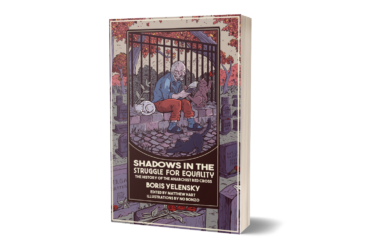Millennials Are Killing Capitalism
In this episode we have a roundtable discussion grounded around the book The Mohawk Warrior Society: A Handbook on Sovereignty and Survival. For this discussion we have all four of the editors of this book, Philippe Blouin, Matt Peterson, Malek Rasamny and Kahentinetha Rotsikarewake. In addition two other members of Kanien’keha:ka Kahnistensera (Mohawk Mothers) joined the conversation Karennatha and Arizawe Kahnawake.
The book we discuss does a lot of things. It presents the works of Louis Karoniaktajeh Hall, it discusses what the Mohawk Warrior Society is, and Louis Hall’s influence and participation and activation of that movement as an autonomous political force. It also discusses some of the history of their vibrant and at times quite successful struggles against colonialism, but also against forces of assimilation, annihilation, and appropriation. The book also provides a number of resources to help understand the philosophy embedded in Mohawk language and thought, in which the Mohawk Warrior Society is grounded. This is a sovereign tradition of anticolonial resistance to genocide that crosses the imposed colonial borders of the US and Canada, and still exists in defiance of setter law and ways of knowing. As is discussed in the show, it is also potentially a guide or an offering. The Mohawk Warrior Society has out of necessity often been a somewhat secretive formation, this book and conversation offer a glimpse into their world view, and it’s incumbent upon us to listen in and take note.
This virtual roundtable features six guests. Due to time constraints there is just a lot that we weren’t able to get to in this conversation and so we really encourage folks to pick up the book and read it. We’ll include links in the show notes.
The book’s editors and our guests are:
Kahentinetha Rotiskarewake is a Kanien’kehá:ka (Gon-e-en-gay-ha-ga) from the Bear Clan in Kahnawà:ke. Initially working in the fashion industry, Kahentinetha went on to play a key role as speaker and writer in the Indigenous resistance, a role which she has fulfilled consistently for the last six decades. During this time, she witnessed and took part in numerous struggles, including the blockade of the Akwesasne border crossing in 1968. She has published several books, including Mohawk Warrior Three: The Trial of Lasagna, Noriega & 20–20 (Owera Books, 1994), and has been in charge of running the Mohawk Nation News service since the Oka Crisis in 1990. She now cares for her twenty children, grandchildren and great-grandchildren. Kahentinetha means she who is always at the forefront.
Philippe Blouin writes, translates and studies political anthropology and philosophy in Tionitiohtià:kon (Montréal). His current PhD research at McGill University seeks to understand and share the teachings of the Teiohá:te (Two Row Wampum) to build decolonial alliances. His work has been published in Liaisons, Stasis and PoLAR. He also wrote an afterword to George Sorel’s Reflections on Violence.
Matt Peterson is an organizer at Woodbine, an experimental space in New York City. He is the co-director of The Native and the Refugee, multimedia documentary project on American Indian reservations and Palestinian refugee camps.
Malek Rasamny co-directed the research project The Native and the Refugee and the feature film Spaces of Exception. He is currently a doctoral candidate in the department of Social Anthropology and Ethnology at the Ecole des hautes études en sciences sociales (EHESS) in Paris.
And as I said Karennatha and Arizawe Kahnawake who are two other members of Kanien’keha:ka Kahnistensera (Mohawk Mothers) joined the conversation as well. It was an honor to host them.
And if you appreciate conversations like this, we are on a push for the month of March to add 40 patrons, we’re about half way there, and we have just less than half of the month remaining so kick in $1 a month and join the wonderful people who make this show possible and become a patron of the show. You can do that at https://www.patreon.com/millennialsarekillingcapitalism
Other links:
Support the MAKC/Prisons Kill book club
Buy the book from Massive Bookshop
Conversation at Concordia referenced in the episode.

The first collection of its kind, this anthology by members of the Mohawk Warrior Society uncovers a hidden history and paints a bold portrait of the spectacular experience of Kanien’kehá:ka survival and self-defense.
Providing extensive documentation, context, and analysis, the book features foundational writings by prolific visual artist and polemicist Louis Karoniaktajeh Hall (1918–1993) — such as his landmark 1979 pamphlet, The Warrior’s Handbook, as well as selections of his pioneering artwork. This book contains new oral history by key figures of the Rotisken’rhakéhte’s revival in the 1970s, and tells the story of the Warriors’ famous flag, their armed occupation of Ganienkeh in 1974, and the role of their constitution, the Great Peace, in guiding their commitment to freedom and independence. We hear directly the story of how the Kanien’kehá:ka Longhouse became one the most militant resistance groups in North America, gaining international attention with the Oka Crisis of 1990. This auto-history of the Rotisken’rhakéhte is complemented by a Mohawk history timeline from colonization to the present, a glossary of Mohawk political philosophy, and a new map of Iroquoia in Mohawk language. At last, the Mohawk Warriors can tell their own story with their own voices, and to serve as an example and inspiration for future generations struggling against the environmental, cultural, and social devastation cast upon the modern world. (From Between the Lines)
Louis Karoniaktajeh Hall was a prolific Kanien’kehá:a painter and writer from Kahnawake, whose work continues to inspire generations of Indigenous people today.






